THURSDAY
NOVEMBER 30 - 2017
Fox
in garden
This
afternoon, my wife excitedly alerted me to the fact
that we had a Red Fox in the back garden. Wow! When I
arrived at the window this beautiful animal was
walking serenely across the grass. By the time I had
got my camera out the Fox had hopped up onto the back
wall and then, after a few seconds, disappeared
through the hedge into my neighbour's garden. I don't
think it found much of interest in the garden, but
what a cracking animal.
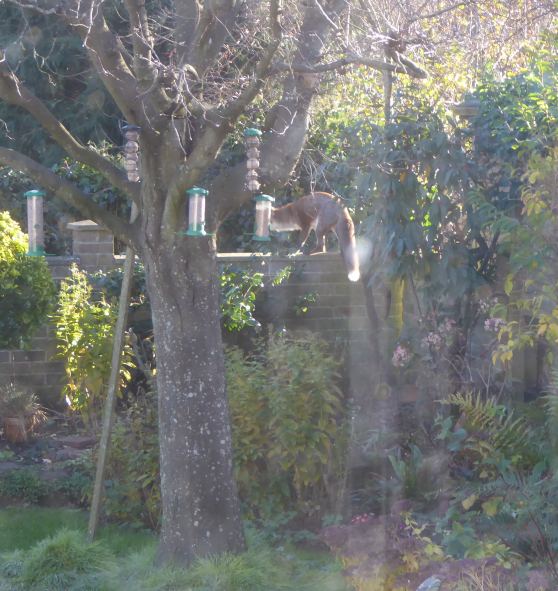
Although Foxes are
certainly not uncommon in urban areas, this was only
the second time we have seen one in our garden. The
first was on 10 June 2012. I also vividly recall
finding a dead Fox on the pavement several years ago,
having been struck by a passing vehicle.
Millpond
and Harbour birds
I wrapped up
warm this afternoon for a walk around the town
millpond. I counted 33 Coot which is probably the
start of the winter invasion. I wonder if we shall see
any Tufted Duck this year. There was no sign of the
Goosander.
Looking into the harbour, it was good to see Lapwing
and Grey Plover feeding on the edge of the low water
channel near the quay in the late afternoon sun.
Finally, this Little
Egret is a regular feeder at the southern outlet from
the millpond near the Emsworth Sailing Club, and today
I watched it for a couple of minutes peering intently
into the water, sharp bill at the ready. Or was it
simply admiring its own reflection?

WEDNESDAY
NOVEMBER 29 - 2017
Our
local seal population
Ralph Hollins
sends the following information relating to the
population of seals in the local area:
"The
local free paper (the Hayling Islander) came through
my letter box yesterday and had a short article about
a survey the Hampshire Wildlife Trust are doing as
part of their new emphasis on Marine Life.
This claimed that they are making an aerial survey of
the Solent area each August (when the Harbour Seals
are moulting their coats and so spend most of their
time hauled out on mudflats and so can be counted from
the air) and this gives them an estimated population
in the Solent area of 49 Harbour Seals (including
11 pups) plus 7 non-breeding Grey Seals.. The
aerial survey has also allowed them to extend the
survey area west to Newtown on the IoW and Beaulieu on
the mainland.
Yesterday I wrote a blog entry incorporating this new
info with the piece I wrote in 2014 when the
Portsmouth Canoe Club produced a web page on the
subject after hearing a talk on a previous version of
this survey using GPS and Depth Measuring collars
attached to a few Seals."
- See . . .
http://ralph-hollins.net/Diary.htm
Sue Thomas got this
photo of a group of Harbour Seals on the sand banks in
the Emsworth Channel in August.

Also of possible
interest is an email Ralph had today from Tony
Gutteridge in Havant saying he had seen a Yellow Flag
(Iris) flowering yesterday in Langstone Pond.
TUESDAY
NOVEMBER 28 - 2017
Nore
Barn
12.30 - Tide
far out. A large flock of Black-tailed Godwits
was mostly snoozing on the green swards of algae, some
separately feeding. I counted 135 in all, which is my
best count of the winter so far. Numbers often rise to
over 150 in Jan-Feb. Most of the Godwits had their
legs hidden, so I could not read any rings.

This is what they look
like closer up.
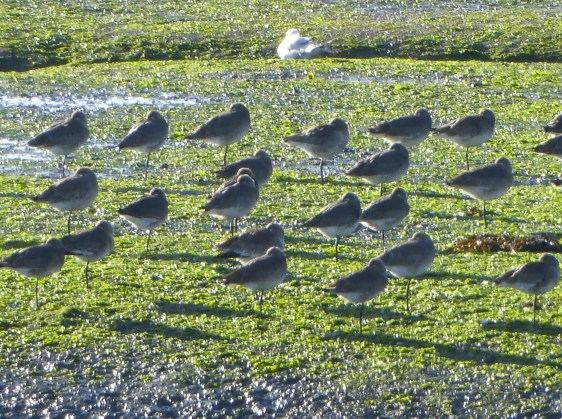
I also spotted the
Brent Goose family with 2 juveniles, probably
the same family that I saw on Nov 11 and Peter
Milinets-Raby saw on Nov 21. That looks as if it is
the only Brent Goose family in Emsworth Harbour this
year. I did not get a picture of them today, so here
is one I took of the family on Nov 11.

It looks as if
breeding productivity for the Brents has been almost
zero this year. This does happen, some years are down
and others are very good, but the jolly Brents carry
on regardless. Fortunately they are fairly long-lived
birds and can withstand the odd barren year.
Emsworth
Harbour 13.00.
Tide rising in the main harbour. A small group of 4
Dunlin was feeding in their typical frenzied
fashion on the edge of the channel close to the
millpond seawall.

This short video clip
shows this distinctive behaviour nicely. No other
birds feed like that. https://youtu.be/h14pM4kFdzQ
Ironbridge
Flower Picture
While browsing
around the charity shops in Havant this afternoon, I
came across a large framed watercolour painting
entitled 'Wild Flowers of the Ironbridge Gorge' by
Mary Grierson that simply took my breath away. I had
to have it - a snip at £10. Mary Grierson was new
to me, but a quick Google search revealed she was one
of the finest botanical artists in the world and
worked at Kew Botanical Gardens as the herbarium's
resident artist. Her work is held in museums around
the world, but the biggest collection is at Kew which
has more than 1,000 of her watercolours and pen and
ink drawings. She died in 2012 aged 99 years! I gather
the original watercolour, of which mine is a print, is
in the Lady Labouchere collection of the National
Trust, Dudmaston, Shropshire. This photo does not do
it justice, but shows the range of flowers.

It is really a
delightful picture and I can just imagine Mary going
down the gorge, collecting a bunch of flowers and
arranging them in a local tankard. The tankard stands
on a tree stump with Many-zoned Polypore fungus
growing on it and dead Bracken scattered over it with
a single Jay's Alula feather. In the background on the
right is the Darby house, Sunniside with trees and a
small group of Fallow Deer.
As soon as I got home, I hung it on the wall and set
about identifying the flowers in the painting which
was great fun. Rosebay Willowherb (in flower), Common
Ragwort (flowers), Traveller's Joy (in flower),
Bittersweet (with berries), Broad-leaved Dock (dead
seed heads), Bramble with berries, Bracken (dead), Dog
Rose hips. There is also a Small Tortoiseshell
butterfly, a Honey Bee (in flight) and a Ladybird (on
Dog Rose). I have yet to identify the curly grass on
the left.
Barrie's
Sparrowhawks
Barrie Jay
sends a few more photos of the male Sparrowhawk that
regularly visits his garden, well-stocked with juicy
morsels (ie Goldfinches). Barrie's name for him is
'Old Beady Eye' and has observed that only Magpies
dare to stay around when he is present, in fact, they
sometimes chase him away!

Barrie says the wire
mesh bird feeders shown in his photos in yesterday's
blog were purchased from Mole Country Store in Wickham
and are specifically designed for sunflower hearts. I
will try to get hold of a couple for my garden, though
I have not seen any on sale local to Emsworth.
MONDAY
NOVEMBER 27 - 2017
Emsworth
Goosander
John Arnott
saw the Goosander on Emsworth Millpond on Friday 24
Nov and managed to get a video clip of the bird having
a good wash and brush-up. Here is a link to John's
video on YouTube . . . https://youtu.be/l-IzoMOk1ds
John wonders whether
the bird might be a male in late eclipse plumage
rather than a juvenile. He says juveniles should have
pale irises (as in the Collins Bird Guide), but the
Emsworth bird appears to have dark irises. John points
out that the photo of an eclipse male Goosander in
Wild Guides Britain's Birds (page 59) looks very
similar to 'our' bird.
I have looked through some of my photos of the
Emsworth Goosander and the question of the iris
colouring is not clear. However, here is one where the
irises appear to be quite pale.
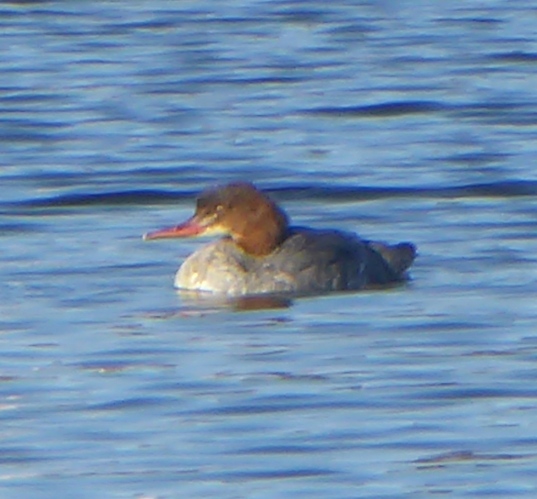
Emsworth
from the air
John Annett
had his first ever flight in a microlight on Nov 26
and got some excellent pictures of Emsworth from the
air. Here is a particularly nice one of the Town
Millpond also showing the eastern foreshore and the
start of Western Parade in the distance.

Goldfinches
and Sparrowhawk
Barrie Jay
writes to say that he gets masses of Goldfinches in
his Waterlooville garden, the number eating at any one
time being dictated by the amount of sunflower hearts
that are available. The 3 large feeders easily attract
18/20 Goldfinches at a sitting. Barrie sends the
following photo by way of proof. Gosh, what a crowd!
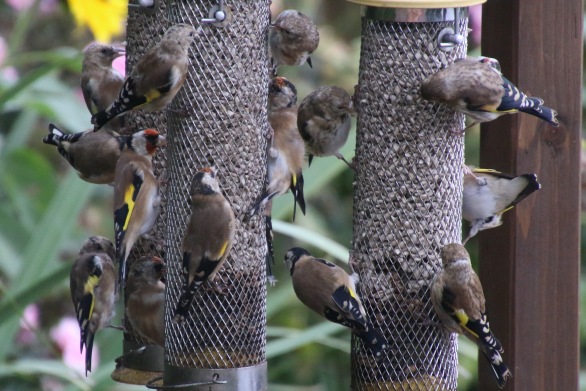
Interestingly, I see
Barrie uses wire mesh feeders, a bit like the ones we
used to use for peanuts until the birds gave up on
them. I would like to try them in my garden. Where do
you get them from Barrie? I have recently discovered
some specially designed sunflower heart feeders with
much smaller holes than the standard feeder; the birds
like them and they lead to less seed falling to the
ground.
Barrie says
Goldfinches are the preferred prey of his local
male Sparrowhawk which once he has consumed a
bird may perch near Barrie's window, seemingly posing
for the camera. Barrie, you are a lucky chap in having
such regular visits from what is undoubtedly the best
garden bird by a mile. I would gladly sacrifice a few
of my equally numerous Goldfinches to have such a
great bird. And, wow, what a cracking photo. Well
done.
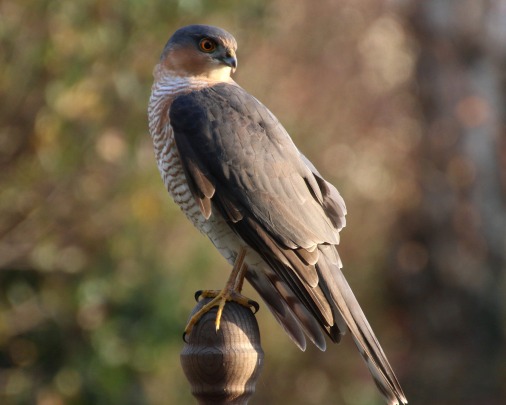
Peregrine
prey
Bryan Pinchen
writes to say that the Peregrine prey photographed by
Tom Bickerton (in this blog on Nov 21) looks far more
like the head of a Brent Goose than that of a Carrion
Crow which it was originally identified as.
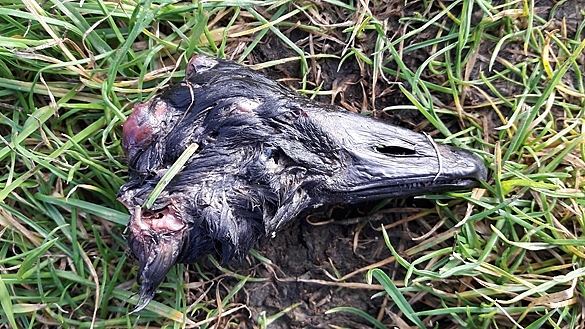
Bryan says, ". . . the
bill is much too short, stout and thick for Carrion
Crow which is more slender and pointed, there appears
to be a series of 'teeth' along the base of the upper
mandible, which would be absent in Carrion Crow, the
tip of the bill is too broad and the extreme tip
appears slightly down-turned for grasping or pulling
at grasses etc. when grazing, whereas it would be
pointed in Carrion Crow, and the nostril is too long
and in the wrong place (half way along the upper
mandible in the picture), on Carrion Crow it is
smaller, closer to the base of the bill and largely
hidden by the basal bristles characteristic of many
corvids. The head shape is wrong for Carrion Crow
too."
Bryan agrees that
Peregrine rarely takes Carrion Crows (in his
experience) although he has been blessed to have seen
a female Goshawk take a Carrion Crow out of the sky
once - "a truly memorable experience".
SUNDAY
NOVEMBER 26 - 2017
Millpond
News
I had a walk
around the town millpond, but there was no sign of the
juvenile Goosander which Nicola Hammond saw a
couple of times earlier in the week.
Meanwhile, a Black Swan was on Slipper Millpond
feeding with the local Mute Swan cygnets and Mallard.
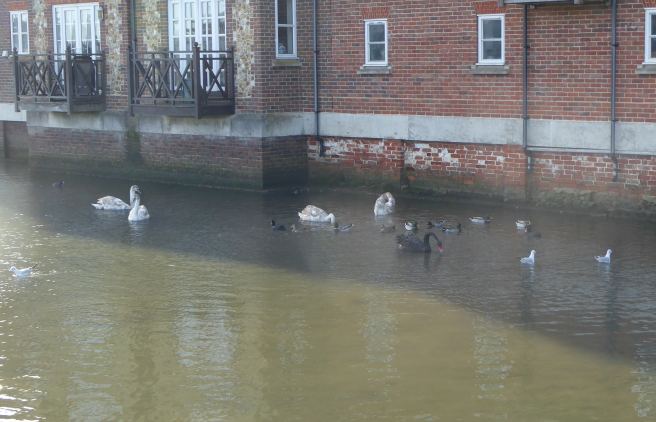
It was a bit
aggressive to one of the cygnets while I was
there.
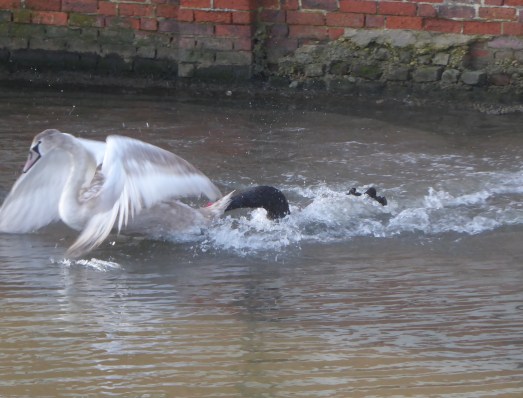
The last local Black
Swan that I heard about was a single with a group of
11 Mute Swans seen by Kate L'Amie on July 18 this year
at Nore Barn. Previous to that we had that
long-staying group of 6 Black Swans in Emsworth
Harbour from Jan 27 until Mar 11.
Garden
birds
November has
been a pretty good one for birds in my Bridge Road
garden with 20 species recorded as follows: Blackbird,
Blue Tit, Chaffinch, Coal Tit, Collared Dove, Dunnock,
Goldcrest, Goldfinch, Great Spotted Woodpecker, Great
Tit, Greenfinch, House Sparrow, Little Egret,
Long-tailed Tit, Magpie, Robin, Sparrowhawk, Starling,
Woodpigeon, Wren.
Here are two birds I
snapped just this morning feeding on the fat balls,
Blue Tit and Coal Tit. I put an extra
shot of the Coal Tit showing its very distinctive
white nape patch on the back of its head.
Goldfinches prefer the sunflower hearts, though
they are awfully messy eaters.
Joyce Sawyer had this magnificent Sparrowhawk
visit her Emsworth garden today, looks like a female
from its size.

SATURDAY
NOVEMBER 25 - 2017
Emsworth
Goosander
I have not
seen the juvenile Goosander that was first seen in
Emsworth on Nov 16 for about 5 days and was beginning
to wonder if it had moved on. However, I was delighted
to hear from Nicola Hammond that she had a very good
view of it yesterday (Nov 24) in Emsworth Millpond,
swimming and diving just 3-4 metres away from where
she was standing in Bath Road. She also saw it on
Tuesday (Nov 21). That's brilliant. I would be
grateful for any sightings or photos. Nicola did not
get a photo, but here is one I got on Nov 19.

Warblington
shore
Despite
disturbance from a Peregrine and two shooters, Peter
Milinets-Raby managed to have a reasonable morning's
birding to the Warblington shore (7:35am to 10:15am -
very low tide). His report follows . . .
"On reaching Conigar
Point, two shooters & "Luna" the dog were leaving.
They had only bagged a few Teal and in the process
left the area deserted. After 20 minutes, 4 Shelduck
returned, pus a Grey Plover and 5 Brent Geese. In the
channel were 2 Red Breasted Mergansers and flying west
were 3 Sandwich Terns. Skylark and Meadow Pipit heard
flying over. Otherwise nothing!!
In the hedge of the SSSI field were 2 Redwings and a
Fieldfare.
Off Pook Lane on first
glance there were lots of waders to be seen. I had
just counted the 33 Bar-tailed Godwits, when
everything took to the air in mass panic. The culprit
was a juvenile Peregrine that had several failed dives
for birds, before 2 Herring Gulls and a Carrion Crow
chased it. The Peregrine retaliated by chasing the
crow and had several dives at the crow, before the
gulls won the day and saw the bird off east towards
Thorney Island. The Barwits did not return. After 10
minutes everything settled down and I continued my
count.
214 Dunlin, 9 Grey Plover, 259 Brent Geese (some
headed inland to north Hayling Island, when the
Peregrine attacked), 53 Shelduck (bunched together by
the Peregrine), 3 Lapwing (were probably 15+ more
before the Peregrine arrived), 126 Black-tailed
Godwit, 22 Wigeon, 48 Teal, 1 Red Breasted Merganser,
2 Greenshank, 1 Turnstone, 2 Sandwich Tern resting on
the mud.
Langstone Mill Pond:
20 Teal, 4 Grey Herons (one perched on the obvious big
nest!!), 1 Grey Wagtail, male Shoveler (asleep see
photo).

Cemetery: 3 Redwing, 1
Stock Dove.
In various fields around Warblington Farm were 8
Curlew, 13 Little Egrets (9 together in the field by
Pook Lane) and 1 Cattle Egret on its own
briefly in the second field north of the black barn,
before flying over the hedge into its favoured
un-viewable field.
FRIDAY
NOVEMBER 24 - 2017
Emsworth
Harbour
I had a walk
around the town millpond this morning, but there was
no sign of the juvenile Goosander. In fact, I
have not seen it for the past 4 days and I think it
may have moved on.
The tide was fairly well advanced in the harbour, but
a few Black-tailed Godwits were still feeding
on the exposed mudflats below the millpond seawall.
They included a very old friend of ours, namely
colour-ringed Godwit G+WR. This bird must feel
really at home in Emsworth since it has been spending
each winter with us since Nov 2008 and today's was my
124th sighting. It must be at least 10 years old, but
looks as good as new as the following photo proves.

Warblington
shore
Peter
Milinets-Raby had 40 minutes spare this morning, so he
visited the Warblington shore off Pook Lane - From 9am
- low tide. He says it was good to see the Bar-tailed
Godwits back again, after a fortnight of not seeing
them and seeing his first Goldeneye on the winter.
Full details as follows: Male Goldeneye, 10 Red
Breasted Merganser, 2 Great Crested Grebes, 57
Bar-tailed Godwit, 216 Dunlin, 11 Wigeon, 328 Brent
Geese, 24 Black-tailed Godwit, 11 Grey Plover, 39
Shelduck, 1 Sandwich Tern, 1 Knot, 2 Meadow Pipit
flying over.
13 Redwing in the cemetery hedge. And in the field
north of the Warblington Farm black barn were 8 Little
Egrets and 1 Cattle Egret (not there when I first
drove by).
Langstone
Mill Pond
In the late
afternoon Peter visited Langstone Mill Pond for an
hour at 2:44pm - high tide, sea as flat as a pancake
and clear visibility - (see photo).

Off shore were 10
Shelduck (with a further 46 of them off Conigar
Point). 3 Red Breasted Merganser, 1 Great Crested
Grebe, 5 Greenshank roosting on the Sweare Deep
island, Kingfisher seen dashing across the water
heading towards the mill, 1 Sparrowhawk flying south
towards Hayling Island.
On the pond were the lingering pair of Shoveler (first
time in five years that this species has lingered
beyond its eclipse enforced autumn stay). They are
both very camera shy (see photo).

Also 2 Mute Swans and
2 Grey Herons. (In the horse paddock were 10 Moorhen,
1 Grey Wagtail and 1 Oystercatcher).
Swan
family
John Jury
captured this nice shot of the local swan family with
their 5 cygnets in Emsworth Marina. The cygnets looked
healthy with puffed up wings. John said the male was
out of the picture chasing off another swan.
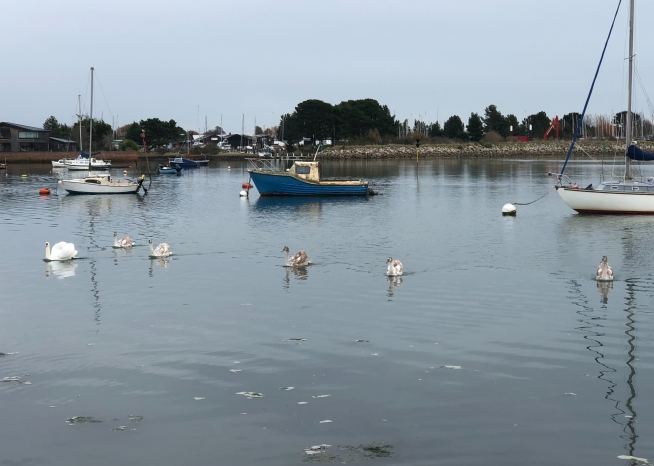
TUESDAY
NOVEMBER 21 - 2017
Emsworth
Harbour
Yesterday
(Monday Nov 19) Peter Milinets-Raby took the
opportunity to have another look at the shore of Nore
Barn and along the western shore to Emsworth Millpond
from 9:07am to 10:56am. Here is Peter's report:
Nore Barn: 91 Wigeon, 213 Brent Geese, 70
Black-tailed Godwit, 79 Teal, 6 male and 18 female
Pintail, 27 Dunlin, 5 Shelduck, 1 Spotted Redshank.
Beacon Square:
91 Black-tailed Godwit, 38 Wigeon, 5 male & 6
female Pintail (combined total of 35, Equals the best
maxima of the last five years - Could this be a good
season for Pintail? December/January are the usual
peak months? Are there more to come? 21 Teal. 87 Brent
Geese (containing probably the only 2 juvs in the
World!!!), 16 Shelduck, 137 Dunlin.
Emsworth
Harbour: Juv Goosander still lazily swimming about
near to the sea wall of the Sailing club, 26 Lapwing,
17 Grey Plover, 184 Brent Geese, 83 Dunlin, 3 Little
Grebe, 2 Coot, On the Millpond were 34 Coot and a
Kingfisher.
Great
Northern Diver
Today, Peter
had a 15 minute lunch break at 1:45pm at Northney.
While there he spotted a Great Northern Diver diving
in Texaco Bay (opposite the Texaco Filling Station).

Peregrine
kill
Tom Bickerton
sent me a photo of a Peregrine Carrion Crow kill he
found recently on Thorney footpath opposite Fowley
Island. . Tom says it is unusual for Peregrine to take
crow, but it is pretty easy bird to catch and needs
must.

Dolphin
Quay Cypress update
I have just
heard from Lesley Harris that Jim Garland has
withdrawn his application to Havant Borough Council
for the felling of the two Monterey Cypress trees in
his garden at 1 Dolphin Quay. Here is an extract from
Mr Garland's circulated letter:
"This
morning I was introduced to Alex Wardle (the owner of
the land either side of the public footpath). We
inspected and discussed the trees and the problems
they are beginning to cause to my boundary retaining
wall. Alex's solution is simple and very generous. She
suggested that the retaining boundary wall under
threat from the southernmost tree is rebuilt in a
slightly altered position so as to allow the tree and
new wall to coexist without endangering each other. In
practice, Alex has offered to gift to 1 Dolphin Quay
the small sliver of land which would make this
possible and allow a discrete realignment of the
boundary wall so that it is not obvious. I have a
meeting with Jamie Gargett (HBC Tree Officer) and Mike
Reed (Tree Surgeon) this Thursday when I will discuss
the practicalities with them. I will also formally
withdraw the notice to fell. A new notice will need to
be submitted to allow for pruning and removal of dead
wood / split limbs as a matter of ongoing
maintenance."
This appears to be a
very amicable solution to the problem.
MONDAY
NOVEMBER 20 - 2017
Millpond
Goosander
The juvenile
Goosander was still present on the town millpond this
morning, busily fishing. The light was awful, but I
took some photos for the record. Here is one of the
Goosander preening.
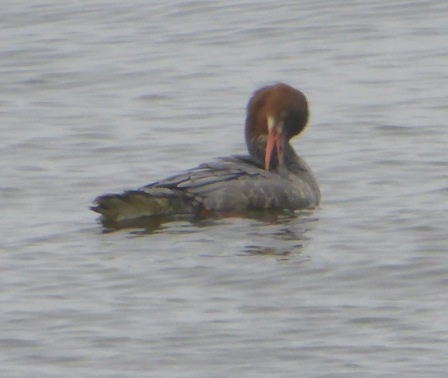
Combing through my old
records, I discoverd number of sightings of a female
Goosander in Emsworth over a 6 week period from late
December 1999 to early February 2000. Most sightings
were on Emsworth Millpond, with a few in the harbour
one or two near Slipper Millpond. This was before
digital cameras so I have no photographic records.
Mute
Swan family
I also visited
Slipper Millpond where I found the Mute Swan family
with 5 cygnets on the water near Brendan
Gibb-Gray's house, back on their home territory, after
an excursion to the harbour where I saw them
yesterday. This pair nested on Peter Pond this spring
and produced 6 cygnets of which 5 survived. They all
look in fine fettle.

Monterey
Cypress trees
While at
Slipper Millpond I took photos of the two Monterey
Cypress trees which grow in the garden of number 1
Dolphin Quay and which overhang the Dolphin Creek
footpath. The first photo shows a view of the two
trees from the now disused Dolphin Quay jetty. They
are difficult to see separately from this distance.
The tree to the right in the photo is a Yew which is
not included in the application to fell.

The second photo was
taken from the footpath that runs to the west of
Dolphin Creek and shows the two Cypress trees with
multiple secondary trunks indicating a lots of earlier
cutting.

Lesley Harris alerted
me to the fact that these magnificent trees are
threatened with felling under a new planning
application by the owners. She urges everyone to lodge
an objection to the felling, but stresses it is URGENT
as objections have to be received by Havant Borough
Council by this Friday 24th November.
Application number - APP/17/01167.
Here is the link . . . https://planningpublicaccess.havant.gov.uk/online-applications/applicationDetails.do?activeTab=documents&keyVal=DCAPR_242216
Lesley kindly sent me
her words of objection: "These
trees appear in the Emsworth Town Centre Tree Trail
booklet published by the Emsworth Tree Warden Group.
They overhang Dolphin Creek footpath and surrounding
land. This land has been gifted to the people of
Emsworth, under the umbrella of Slipper Mill Pond
Preservation Association, by the Wardle family of
Wharf House. It would be a pity if the splendour of
these trees were to disappear and thus diminish the
impact of the gift to Emsworth."
Nick Madina also has
also got the bit between his teeth and is galvanising
the Slipper Millpond Association people to object.
The owner's defence of
the planning application is contained in a letter to
Havant Borough Council which makes interesting
reading. Apparently, the trees are in decline and
threatening the public footpath as well as damaging a
retaining wall. Here is a link to Mr Jim Garland's
letter . . . Jim
Garland letter to HBC
The Monterey Cypress
was first introduced into this country in 1838 from
its native California. It was first used mainly as a
windbreak, but in recent times this role has been
taken over by its offspring, the notorious Leylandii.
It is very salt resistant and on the Monterey
peninsula in California the tree grows in a narrow
zone between the beach and the sea along with Monterey
Pine. Its leaves are small and faintly aromatic. Its
cones are roundish with leathery scales and can be
seen on the Dolphin Creek trees as shown in the photo
that follows.
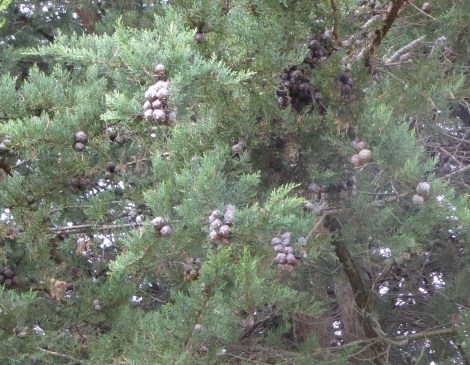
Invasive
algae
David Taylor
posted the following message about an invasive alga
which appears to be causing problems for wildlife.
Keep a look out for it in our area.
"Since
2009, a non-native, red-brown algae, Gracilaria
vermiculophylla, has been present in Poole
Harbour and in 2015 it appeared in Christchurch
Harbour. It is thought the species, which is native to
the north-west Pacific, may have been brought to the
South Coast as the result of oyster farming at Poole.
The species is highly mobile and thrives in water with
low salinity levels and, per those who have studied
it, may be set to spread further. Once established, it
can form a mat over estuarine mud, which effectively
prevents short-billed wading birds, such as Dunlin and
Ringed Plover, from accessing food. This mat can be
several inches thick, as it is in places around
Christchurch Harbour, but can be even denser given the
correct conditions. High levels of nitrates in the
water will almost certainly accelerate its growth.
As a result of this algae, plus higher-than-expected
levels of native algae (probably the result of high
nitrate levels in rivers), the Christchurch Harbour
Ornithological Group, CHOG, have noted a decline in
Dunlin and Ringed Plover using the area during the
autumn passage period, when the algae are most
prevalent. In addition to affecting the ability of
some birds to feed, the algae may give off a very
unpleasant smell.
Here
is an image of Gracilaria vermiculophylla

With
the current spread of gracilaria vermiculophylla being
eastward, it is quite possible it may appear within
the Solent. CHOG are in dialogue with various
organisations, including the Environment Agency and
Natural England, about the situation in Christchurch.
To complement this, if you think you have seen
gracilaria vermiculophylla in the Solent, please pass
details, preferably with photographs, to
secretary@CHOG.org.uk These will then be passed onto
the EA and NE."
SUNDAY
NOVEMBER 19 - 2017
Emsworth
Millpond
I walked round
the town millpond twice today, mainly to check on the
juvenile Goosander. The first time at about 12 noon
this morning the Goosander was showing well on the
pond, though there was quite a bit of disturbance from
model yachts, so I did not get any good photos. There
was also a Great Black-backed Gull on the pond
which I did snap. Maybe one of the Slipper Millpond
nesting pair?

One of the resident
Mute Swan pair was guarding the wall by the
Slipper Mill Sailing Club from a Swan family of two
adults and 5 juveniles outside in the harbour. This is
almost certainly the family from the Peter Pond nest
which I thought might have broken up by now, but they
are still going strong. However, there could be
trouble if they try to invade the town millpond.

I returned to the
millpond at about 3.30 this afternoon. The yachts had
gone and the low sun created attractive patterns of
colour on the surface of the pond. The Goosander was
showing very well again and is clearly quite a tame
bird, coming close to the wall where many people were
walking. It really is a very attractive bird with
lovely chestnut brown head and white neck and chest.
The loral streak beneath the eye, which is a feature
of the juvenile bird, shows up well. It was busy for
much of the time diving for fish, though I did manage
to get a few photos and videos in the intervals in
between. Here are a couple of images showing its main
features.
This short video shows
the features of the Goosander well as well as the
tameness of the bird.
Link to YouTube video . . . https://youtu.be/-4XG7A_CagA
Emsworth
Peregrine
I had a nice
reply from Caroline Richards following her photo in
yesterday's blog of the Peregrine in Emsworth
Harbour.
She says, "We
saw the Peregrine falcon In Emsworth channel 2 miles
south of Fowley island. I took the photo with my
mobile phone from our boat...wobbling around a bit!
When I visited Brendan yesterday the Kingfisher landed
on his balcony; it is also a regular visitor in the
creek now. I love birds & will now follow your
site & try & send you some photos in due
course. Thank you so much for featuring my
photo!"
Caroline's photo was passed on to me by Brendan
Gibb-Gray whose home overlooks Slipper Millpond.
Pagham
hide closure
Christopher
Evans informs me that the Ferry Pool hide at the RSPB
Pagham Harbour Reserve and the path leading to it,
will be closed from tomorrow until early 2018. A new
hide is being constructed, as well as additional
remedial work to the nearby Discovery area. Speaking
to one of the wardens, he thought that the reopening
time might not be until March.
SATURDAY
NOVEMBER 18 - 2017
Emsworth
Harbour
Peter
Milinets-Raby was up before dawn to do some serious
Birdin' (with a 'g') - A Radio 2 reference. He visited
the Emsworth area from 7:16am to 9am (when the drizzle
moved in - yuk!). Here is his report in full . . .
Emsworth
Harbour:
The juvenile Goosander was one of the first
birds seen fiddling about by the jetty by the sea
wall. And, it even swam into my sunrise photo. It then
proceeded to 'fish' along the edge of the shore
shallows, by sticking it's bill in the water and
slowly swimming forward like a Hoover!
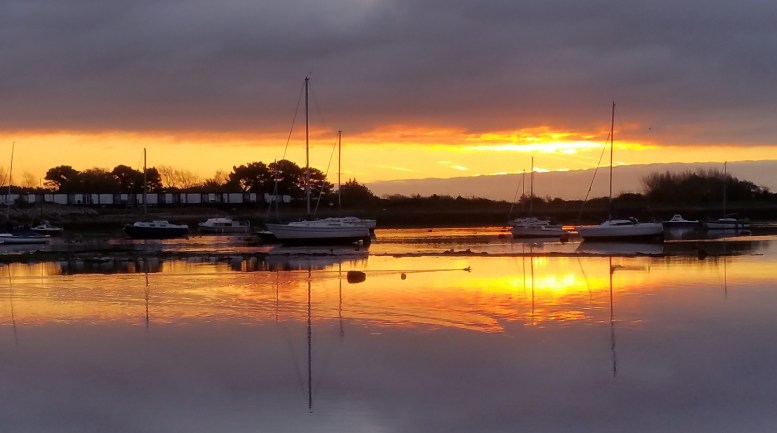
A Kingfisher was seen
several times dashing over the Emsworth Mill Pond and
in the short lived golden flash of the sunrise the
iridescent colours of the bird sparkled with a truly
magical quality. Amazing views - No Kingfisher in the
photo, but it could easily be imagined!! Also on the
pond were 23 Coot.
Out in the harbour as
the tide pushed in were: 3 Greenshank, 7 Black-tailed
Godwit, 1 Lapwing, 5 Coot, 343 Brent Geese, 9 Teal, 2
Little Egrets, 5 Grey Plover, 7 Shelduck, 179 Dunlin,
18 Turnstone.
Beacon Square
from 8:01am: 171 Brent Geese (this flock contained 3
Juveniles - the first I've seen). 32 Wigeon, 9 Ringed
Plover (colour rings ( -//- + R//LY & -//- + N//YW
& -//- + G//RO), Colour ringed Redshank (-//G +
G//YG), 99 Black-tailed Godwits (R//R + LG//- &
ROL//- + RLR//- & O//R + WL//- & R//R +
GL//-), 2 Grey Plover, 2 male and 3 female Pintail, 2
Shelduck, 20 Teal, And 7 Skylark flew over heading
west.
Nore Barn from
8:36am: 6 Black-tailed Godwit, 3 male and 13 female
Pintail, 99 Wigeon, 87 Teal, 2 Grey Plover, 1
Greenshank (G//R + GL//-) with it's friend the Spotted
Redshank in the stream. 61 Dunlin, 8 Shelduck, 199
Brent Geese.
1 Kingfisher fishing
from one of the navigation posts, then a dog dashed
into the sea to flush most of the birds and two guys
in a motorised inflatable dingy wiped everything else
out as they travelled south. I've never seen Nore Barn
look so empty - even the gulls had vacated!
Note on Peter's
colour-ringed Black-tailed Godwits
O+WL - 16th sighting in Emsworth Harbour. First seen
on 25-Sep-12 and last seen on 09-Oct-17.
R+LG - 14th sighting in Emsworth Harbour. First seen
on 23-Oct-13 and last seen on 01-Nov-17.
R+GL - 38th sighting in Emsworth Harbour. First seen
on 10-Sep-10 and last seen on 09-Oct-17.
ROL+RLR - 102nd sighting in Emsworth Harbour. First
seen on 23-Oct-09 and last seen on 29-Oct-17. An old
friend.
Goosander
correction
I can now
accept that the 'Red-breasted Merganser' reported in
this blog yesterday on the town millpond was in fact
the juvenile Goosander seen the previous day (and
again today) by Peter Milinets-Raby. Thanks to Peter,
Ralph Hollins and John Arnott for pointing out my
error. I hang my head in shame.
Here are a few
more photos of the millpond bird from yesterday.
Here, for comparison
is a small flotilla of female/juvenile Red-breasted
Mergansers (or are they?)
Taken on Emsworth Millpond a few years ago

Peregrine
in Emsworth
Caroline
Richards got this nice shot of a Peregrine perched on
a fancy buoy in Emsworth Harbour yesterday (Nov 17).

FRIDAY
NOVEMBER 17 - 2017
Emsworth
Millpond
I have a walk
round the town millpond late this morning. The tide
was full in the harbour with no sign of the Goosander
that Peter Milinets-Raby saw yesterday. However, I did
spot what I am fairly sure is a female Red-breasted
Merganser on the millpond - the first of the
winter - though I am prepared to be corrected! Female
Red-breasted Merganser can be confused with female
Goosander, but to me those red eyes in the photo are
decisive! While I was watching the Merganser a
Kingfisher flew low across the surface of the water.

The resident pair of
Mute Swans was doing their regular patrol of the wall
separating the millpond from the harbour, making sure
strangers do not trespass.

THURSDAY
NOVEMBER 16 - 2017
Brook
Meadow
There was a
record turn out for the work session, no doubt spurred
on by Maurice Lillie's 'call to arms' for help in
clearing the river bank south of the north bridge.
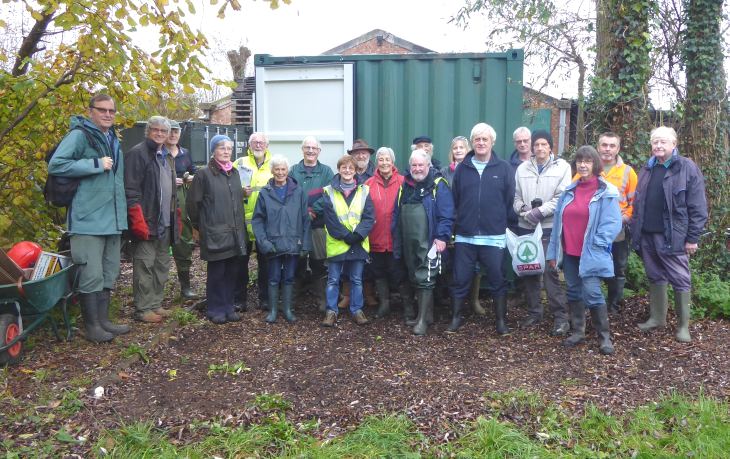
The river and its
banks have deteriorated badly over the past 10 years
or so and must be a contributory factor in the loss of
Water Voles from the site. Here are two photos taken
from the same position near the observation fence to
show how the river has changed - now (Nov 2017) - then
(Feb 2003)
Andy Skeet from HBC
(Norse) was present to cut the larger branches. He was
ably assisted by several volunteers who donned waders
and plunged into the river to haul out branches and
other vegetation. Andy is in orange.

A link to a short
video on YouTube of the volunteers at work . . .
https://youtu.be/9J2Un3d0WQo
Another short video
taken a little later with Andy Skeet cutting thick
branches . . . https://youtu.be/YYqA5heSB4c
On the wildlife front
I noticed how well the Common Polypody Fern on
the north bridge has grown over the past few years. It
now occupies a about a metre of the bridge and looks
like increasing further.
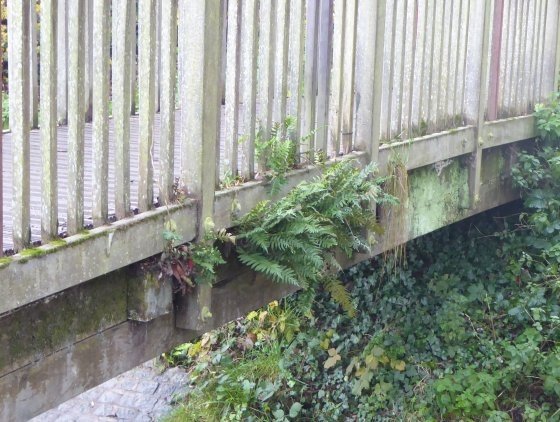
Emsworth
Harbour
Peter
Milinets-Raby had a couple of visits today. The first
was to Nore Barn and a walk along the front to
Emsworth Mill Pond 9:03am to 10:17am tide almost in
and sea as flat as a pancake - see photo.
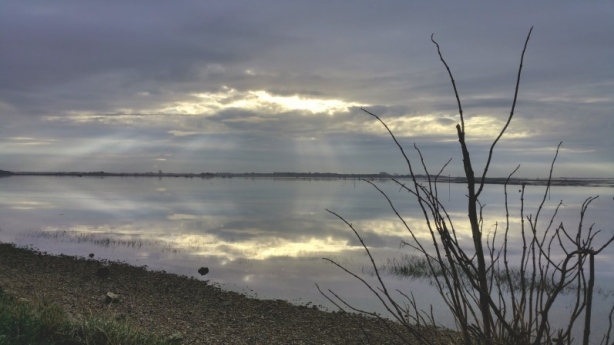
Peter's report . . .
"Sitting on the buoys were 5 Sandwich Terns. Roosting
and asleep by the stream were a Greenshank, Spotted
Redshank and a Redshank. 336 Brent Geese, 12 Teal, 44
Wigeon, 5 Shelduck, 1 Little Grebe.
Off Beacon Square: 18 Turnstone roosting on several
buoys, 78 Brent Geese, Male Red Breasted Merganser.
Emsworth
Harbour: A nice find was a juvenile
Goosander that was fiddling about by the pier off
the Emsworth Sailing Club. It then swam along the edge
of the sailing club building and arrived at the steps
by the sea wall, where it then proceeded to swim
towards me stood on the sea wall. It alas curved out
from the sea wall and passed me at about 25 metres
away, before an approaching dog walker spooked the
bird and it flew south out into the harbour. I managed
to get a passable photo considering it was a very dull
overcast and a very grey day at this point.

Also out in the
harbour were 416 Brent Geese, 5 more Turnstone
roosting on buoys, 6 Little Grebes, 5 Coot and a male
Red breasted Merganser. On the pond were 20
Coot."
Langstone
Mill Pond
Later in the
day Peter visited Langstone Mill Pond as the tide was
dropping (1:48pm to 2:47pm) - lovely sunshine.
Peter's report . . . "Off shore: 8 Greenshank (R//G
+YY//- & G//R + GR//- & G//R + BR//-), 290
Dunlin, 7 Common Gull, 2 Sandwich Tern, A Kingfisher
fishing from one of the yachts near the channel, 9
Black-tailed Godwit, 11 Grey Plover, 39 Shelduck, 359
Brent Geese, 8 Red Breasted Merganser, 6 Lapwing, 8
Little Egrets, 1 lonely Bar-tailed Godwit, 5
Wigeon.
On the pond: 91 Teal, 2 Mute Swan, Unusually a male
Gadwall, A male Shoveler, A Grey Wagtail.
The damaged path by
the pond has been repaired with hessian sausage-like
barriers, which will over time be reclaimed by
vegetation. I see they planted a few reeds and other
vegetation to help the process. Looks good, but it
will take away some of the access to feed the ducks in
time. Any ideas whom has done this? Can I have a Tower
hide built in the middle of the northern reed bed to
get close views of the breeding Egrets and Herons and
to see the small pool that is hidden,
please!"

WEDNESDAY
NOVEMBER 15 - 2017
Gaggle
of Geese
During a
stroll along the coastal path to the west of Emsworth
I stopped to listen to the chattering of hundreds of
Brent Geese wafting across the mudflats. A wonderfully
atmospheric harbour sound in winter. Although most of
the birds were scattered around the mudflats, one
group was densely packed together in a line parallel
to the near shore. There were a few Wigeon mixed in
with the Brents. Although I did not count them, there
must have been in the region of 100 birds in this one
tight group. Although it is usually the custom to
refer to a group of wild geese as a flock, I think
this one deserves the name 'gaggle'. There were no
juveniles that I could see.

They all appeared to
be feeding in small pools of water left by the tide,
which presumably contained some tasty morsels. This
behaviour shows up best in the following short video
on YouTube . . . https://youtu.be/nFSHLmpDZuc
Greenshank
RG+BY
John Jury was
at Nore Barn today and got this nice shot of a Little
Egret feeding with a colour-ringed Greenshank with the
combination - RG+BY - the blue ring can just be seen
above the yellow.

This was the second
sighting of this bird in Emsworth this winter, though
it has been a regular wintering bird over the past 6
years. It was originally ringed on 19-Mar-13 by Pete
Potts and his team at Thorney Island. It originally
had a geolocator fitted to the blue ring, though this
may have been removed in a subsequent catch.
Langstone
Mill Pond
Peter
Milinets-Raby has had two recent visits to Langstone
Mill Pond
Tuesday Nov 14
At 1:49pm for an hour at low tide. Birds seen were as
follows: Off shore on the mud: 33 Shelduck. 13 Common
Gulls and 8 Sandwich Terns.

An adult Mediterranean
Gull dip-diving along the trickle in the channel.
Where do all these birds go come winter time? This is
my first sighting for over a month and probably the
last one I will see now until mid February. Getting to
become a scarcity in the deep winter months.
82 Teal, 1 female Red Breasted Merganser, 317 Brent
Geese, 45 Dunlin, 13 Grey Plover, 16 Wigeon, 9 Little
Egrets feeding in the trickle of water in the channel,
11 Black-tailed Godwit. In the distance off Conigar
Point were 18 Shelduck.
On the pond were 59 Teal, the female pond Pintail, a
pair of Shoveler, a Goldcrest, 4 Stock Doves, a single
Little Egret, just one obvious Grey Heron and 8
Moorhens on the paddock.
Monday 13th
November:
Warblington shore from Noon for an hour - low
tide. 3 Redwing in the cemetery and Jay heard. 10
Curlew in the field south of the cemetery with Grey
Wagtail.
Off Pook Lane: 18 Lapwing, 1 Red Breasted Merganser,
81 Dunlin, 12 Grey Plover, 351 Brent Geese (all adults
- seen well - this is the largest number I have
counted with a no juveniles). 30 Shelduck, 10 Wigeon,
1 Bar-tailed Godwit, 13 Black-tailed Godwit, 8 Little
Egrets, 11 Teal. In the distance off Conigar Point: 43
Brent Geese, 6 Shelduck.
And, when leaving. In
the same tree as last time (in field north of the
barn) for two minutes were 5 Little Egrets and 1
Cattle Egret (see photo). Again, it flew off very
nervously east into the field beyond the big hedge and
out of sight!

MONDAY
NOVEMBER 13 - 2017
Emsworth
walk
I had a walk
through Brook Meadow and down to the harbour this
morning. I found some Hemlock Water-dropwort
still flowering on the Dolphin Quay path.

As I walked up the
path to King Street, the 'town hall' clock above the
garages in the garden of Quay House chimed the
three-quarter hour - 11.45. A lovely clock.

Walking round the
millpond seawall I could see lots of Brent Geese in
the low water channel, but too far to age without a
scope. However, several Black-tailed Godwits
feeding on the green seaweed shore near the seawall
were within the range of my camera. Checking the
Godwits for rings I found a very old friend -
G+WR - back in Emsworth Harbour for the 9th
winter running. It was originally ringed at Farlington
Marshes on 10-Sept-08 as adult male. Today's sighting
was my first of the present winter period and my 123rd
in total. This make the bird at least 10 years of age
- a good age, but not a record for Black-tailed
Godwit? Its rings are still in remarkably good
condition considering their age.

Little
Grebe late nesting
Tom Bickerton
sent this photo he took during a low-tide count at
Hayling Island of a male Little Grebe sitting on a
nest. It is unusual for these birds to nest so late,
but Tom thinks it is connected to an abundance of
natural prey items, incredibly warm weather and the
opportunity from the lack of fellow breeders.

Tom says this pair has
tried 3-4 times to breed, but as a pair they have
remained on territory. The early clutches failed
probably at egg stage, due to predation either by rats
or coot. Their last breeding was a success, which
meant both adults retained their breeding plumage. Two
juveniles were also close by the nest, which indicated
a family unit, but Tom thinks neither of these birds
have moulted.
Tom added, Little Grebes start nest building in early
April. If we assume two clutches are produced then
that'll take us into July for the last fledging. The
indications are that at least one these clutches
failed, probably both. This would enable another
breeding attempt ending in October, which was probably
successful, hence the attempt in November as both
adults are still sexually active. The oddity is that
the other adult grebes have moulted into their winter
plumage.
Will they survive? Tom was surprised to see them both
on the nest, but chances are slim.
SATURDAY
NOVEMBER 11 - 2017
Nore
Barn
I had a quick
look at Nore Barn from 3.00 to 3.30 on a rising tide.
The stream was already filling fast and two Spotted
Redshanks were snoozing on the edge of the stream
along with 3 Common Redshanks. This was my first
sighting of two Spotshanks this year.

I walked along the
path south of the woods to check the Brent
Geese assembling in the creek. I counted 152
Brents which included one family with 2
juveniles - my first family of the winter. So far
this winter I have aged a total of 689 Brents with
just 3 juveniles, giving a proportion of 0.44%. It
looks as if the geese have had a disastrous breeding
season.
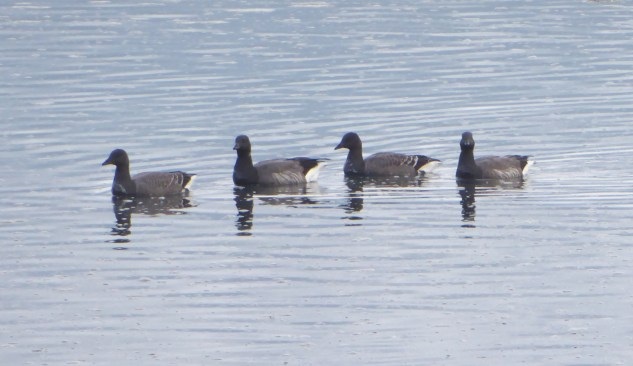
Langstone
Mill Pond
Peter
Milinets-Raby visited Langstone Mill Pond yesterday
(10th November) from 9am to 10am.
The highlight was watching a pair of Grey Herons
mating on the nest at the top of the Holm Oak. The
male departed and the female snuggled down onto the
nest. This is VERY early, compared to the last two
breeding seasons. I assume the female will now lay
eggs, probably over the next week, giving a possible
hatching date of roughly 13th December - truly an
early Christmas present!
Other birds seen were: Female Tufted Duck, 46 Teal,
Female Pintail - not seen this bird's legs to see if
it is ringed and thus confirm that it is last years
bird of funny origin. 3 male and 2 female Shoveler,
30+ Goldfinch, 8 Grey Heron loitering, 2 Mute Swan, 1
Sparrowhawk circling over with intent. Kingfisher
dashed across the pond. Water Rail flew across the
pond and quickly ran along the edge of the reeds
before diving for cover.
Off shore on the extremely low tide mud were 9
Sandwich Terns, 6 Common Gulls, 23 Black-tailed
Godwit, 46 Shelduck, 37 Dunlin, 20+ Wigeon and 7
Bar-tailed Godwits.
FRIDAY
NOVEMBER 10 - 2017
First
Brent juvenile
The tide was
low when I walked along the millpond seawall this
morning against a cold northerly wind with the scope
on the back of the bike. I managed to shelter from the
wind at the bottom of the slipway by the wooden jetty
from where I aged about 200 Brent Geese, less than
half the total number in the harbour. I found just
one lonesome juvenile - my first of the winter;
this little fellow did not appear to be with parents,
but I assume they are around. There were about 20
Brents at the top of the channel near the town shore
where I usually see families, but all were adults.
I did not get a photo of the juvenile Brent today, but
here is one I got a couple of years ago in Emsworth
showing the distinctive white bars on its wings.

Millpond
interpretation board
On the way to
the harbour I stopped to have another go at cleaning
the interpretation board on Bridgefoot Path on the
east side of millpond. I had a go a couple of weeks
ago, but could not get all the muck off.
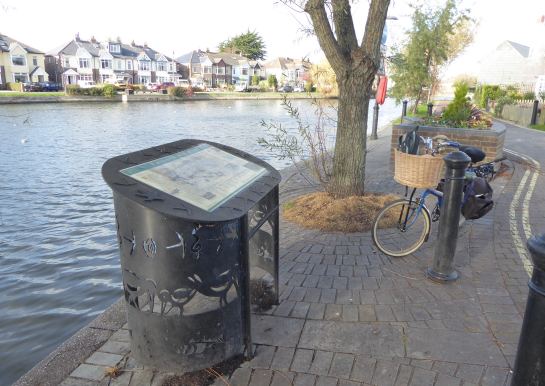
Today's clean helped a
bit, but the window is still looks dirty. While I was
there a chap in a dog collar (the new vicar maybe?)
stopped to thank me for doing such good community
work. I told him I had a stake in the board as I
helped to design it.

To fill in some
history, the millpond information board and its very
attractive metal stand was part of the environmental
enhancement works for Bridgefoot Path, undertaken by
Havant Borough Council in 1999. As well as the board,
these included the raised flower beds and a new one
way traffic system which has had a real beneficial
effect in reducing the traffic along this quiet road.
I was asked to provide information for the board about
the birds using the pond. The artwork was done by Dan
Powell. Here is a photo of the opening ceremony on
Thursday 14 October 1999 when a commemorative plaque
was presented by representatives Hampshire County
Council and Havant Borough Council. Mark Wilson, who
designed and led the project, is the chap with curly
black hair fourth from the right. Mark is no longer at
HBC

Warblington
Peter
Milinets-Raby had a good look around the Warblington
Farm area yesterday (Nov 9) and failed to bump into
any egrets, until literally on his way home, when he
had 3 Little Egrets and 1 Cattle Egret perched
in the tree in the field north of the Warblington
Barn.
Peter said, "They all
preened for 5 minutes, then flew off east to land in
the non viewable field, which is almost certainly
where they were hanging out the entire time I was on
site! As the weeks pass, the farmer will move the cows
around more and the easier viewable fields will start
to churn up. At the movement these fields are looking
like rich green bowls lawns, albeit with a few cow
packs on them! Give it another week and the sightings
will get more frequent, especially as we have more
rain forecast for the weekend!"
Yesterday (Nov 9)
Peter walked around Warblington from 11:13am to 1:30pm
- tide coming in slowly. His report follows:
Off Pook Lane: 138 Black-tailed Godwit (L//R + OG//-),
4 Greenshank, 4 Sandwich Tern, 279 adult Brent Geese,
28 Bar-tailed Godwit, 30 Shelduck, 270+ Dunlin, 7 Grey
Plover, 29 Lapwing, 5 Wigeon, 17 Teal, 1 Knot, 8 Red
Breasted Merganser.
Off Conigar Point: 152 Brent Geese, 69 Wigeon, 3
female Pintail, 3 Teal, 13 Dunlin, 17 Grey Plover, 1
lone Ringed Plover, Skylark heard over. Buzzard in
SSSI field. Tamarisk Hedge: Great Spotted Woodpecker,
1 Goldcrest, 6+ Long-tailed Tits, 5 Meadow Pipits in
fields behind the point.
Ibis Field: 2 Jay, 3 Goldcrest, 1 Buzzard, 1 Stock
Dove.
Brian's
note on Black-tailed Godwit L+OG - this bird was
first seen in Emsworth Harbour on 08-Dec-08 and last
recorded on 18-Jul-17 at Breydown Water, Great
Yarmouth, Norfolk, having stopped off there on its way
from its breeding grounds in Iceland. Here is a shot I
got of the bird in Emsworth Harbour a couple of years
ago.
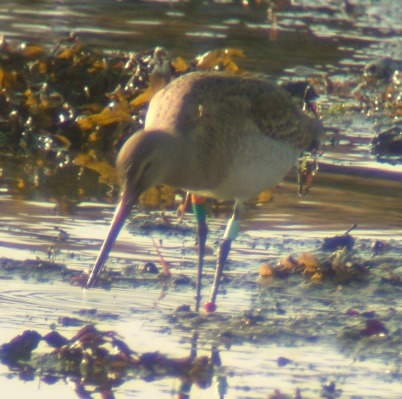
WEDNESDAY
NOVEMBER 8 - 2017
Nore
Barn
I drove over
to Nore Barn late morning (11.30) to catch the rising
tide. The sun was very bright, too bright for easy
birdwatching, or photography. I was pleased to see my
first Pintail of the year in Emsworth Harbour,
one male and three females. They were mixed in with
the regular flock of Wigeon.
I counted 56 Black-tailed Godwits on the
mudflats by the saltmarshes some distance away.

I could just make out
the colour-ringed Black-tailed Godwit G+GR. This bird
has been fairly regular at Emsworth since 2010 at
least; this was my second sighting this winter
period.
I checked the flock of 53 Brent Geese at the
far end of the creek south of the woods, but there was
no juveniles.
The Spotted Redshank was feeding in the stream
alone. I got a quick digiscoped shot.
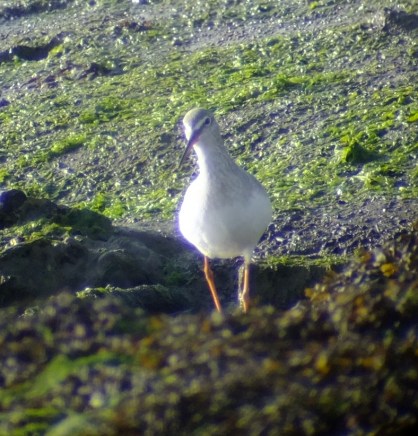
Cattle
Egrets at Warblington
Peter
Milinets-Raby corrected what I said about Cattle
Egrets at Warblington not having been here since 2011
- in fact there was a record 8 birds there last
year.
He says, "After the events of last winter I was
expecting Cattle Egrets to return to the fields around
Warblington to see out the winter months of Late
November to early March. Last year birds appeared in
the Pennington area (just like this year) and after
about two weeks of these Pennington reports, Cattle
Egrets appeared at Warblington. Then in early December
the Pennington birds moved on and as if by coincidence
numbers increased around Warblington. With Cattle
Egrets breeding this year at several sites in the UK,
I am expecting to have more than the Amazing Eight we
had last winter. This is a Hampshire count record. I
am expecting this to be smashed this winter. Stay
tuned!"
TUESDAY
NOVEMBER 7 - 2017
Brook
Meadow
Mike Wells had
a long overdue wander around Brook Meadow on Monday
morning. All the usual Tits were present including
many Long-tailed Tits and he couldn't resist
getting a photo of one dozing! Mike also found a
fungus up a Crack Willow tree in Palmers Rd Copse.
Identification not clear, but possibly Blushing
Bracket (Daedaleopsis confragosa).
Painted Ladies
In response to
my query whether anyone has seen Painted Ladies this
year, Ralph Hollins reports this month the Hants and
Sussex Butterfly sites have had three previous reports
of Painted Ladies - One at Yew Hill near Winchester of
Nov 1, one at Beachy Head on Nov 2, and one at Mill
Hill (Shoreham) on Nov 5. Other butterfly species seen
this month in Hants and Sussex have been Clouded
Yellow, Brimstone, Large and Small White, Small
Copper, Holly Blue, masses of Red Admirals, Small
Tortoiseshell, Peacock, Comma and Speckled Wood plus
two reports of Hummingbird Hawkmoth.
In addition, Jo Bray
tells me has seen five Painted Ladies this year. One
in May at Pennington Marshes. One in June at Levin
Down and three in her Westbourne garden on 12th
August, 22nd Sept, 22nd Oct.
So they are about, but
not in great numbers. Just in case you need a reminder
of how beautiful they are, here is a shot I got of one
on some Michaelmas Daisies on Brook Meadow a few years
ago.
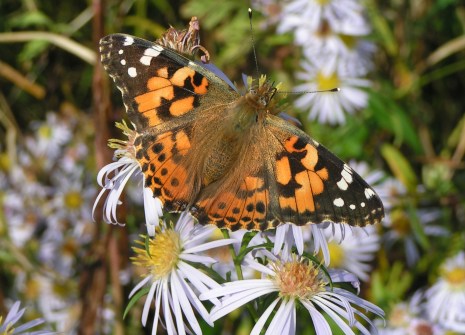
Cattle
Egret at Warblington
Ralph Hollins
alerts me to the first report of a single Cattle Egret
feeding among the cows in the field south of
Warblington Cemetery seen at 08.15 today by M Emberson
(reported on the HOS site). Warblington Farm has been
a popular spot for Cattle Egrets over the years. I
think the last time was in 2011 when Tony Wootton got
this shot of one underneath one of the cows.

MONDAY
NOVEMBER 6 - 2017
Nore
Barn
I drove over
to Nore Barn this morning in time to catch the rising
tide which was a high one (5.0). It was a lovely
morning, though the sun too bright for photography. It
was good to see 52 Black-tailed Godwits feeding until
they got pushed off by the tide. I could not check for
rings as all of them were in water. There was a flock
of 85 Brent Geese at the top of the channel south of
the woods, but still no juveniles among them. I have
yet to see one this winter. There was no sign of the
Spotted Redshank or any other small waders in the
stream.
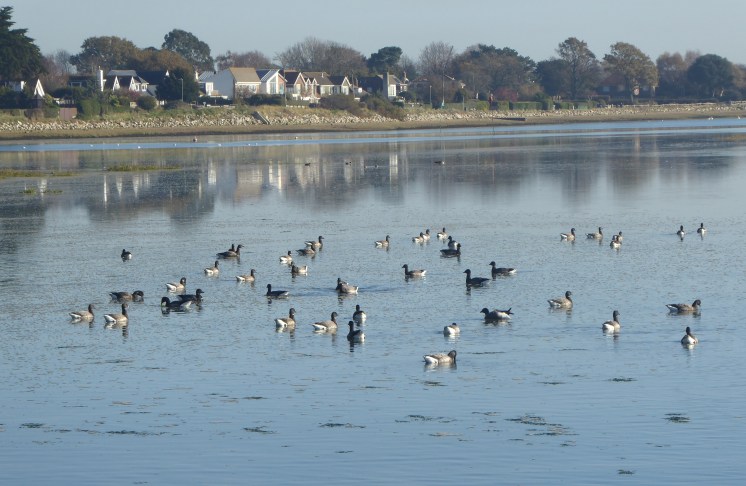
They were feeding on
floating green weed.
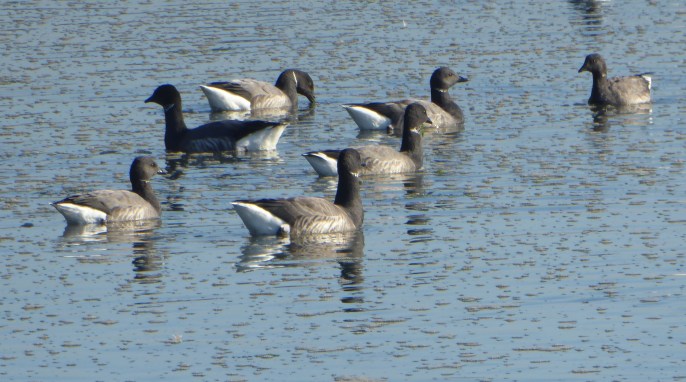
I had a slight trip
while walking back along the beach; I did not fall but
it was scary and a warning to be extra vigilant when
walking over uneven ground. I can't afford another
fall.
Guernsey
Fleabane
During
yesterday's work session on Brook Meadow, Maurice
Lillie mentioned that he had noticed an unusual plant
growing on the area referred to as the 'play area' on
the north meadow. I had a close look at it today and I
think it is Guernsey Fleabane (Conyza
sumatrensis). It was not in flower, though I
have come across it many times in the local area,
usually growing out of cracks in pavements. It is a
recent introduction into this country from S America
and has spread widely, especially in urban
areas.

As can be seen in the
photo, its stem is densely hairy and its leaves long
and narrow edged with hooked hairs. This latter
feature distinguishes Guernsey Fleabane from its close
Conyza relatives, such as Canadian Fleabane. Here is a
photo taken though the microscope (x20) showing the
hooked hairs on the edge of the leaf.

Butterflies
galore
Barry and
Margaret Collins had a good look around Thorney Island
today in what turned out to be a glorious sunny day
and recorded the following species; Clouded Yellow 1,
Speckled Wood 2 and 26 Red Admirals. Has anyone seen a
Painted Lady this year?
Langstone
Mill Pond
Peter
Milinets-Raby had a late visit to Langstone Mill Pond
this evening (4:03pm to 4:43pm - tide going out, sun
going down!)
Off shore were: 7 Teal, 5 Common Gull, 227 Brent Geese
(all adults), 4 Lapwing, 11 Dunlin, 1 Greenshank, 26
Black-tailed Godwit (W//R + WY//- & G//R + WG//-
& G//R + GG//-), 3 Bar-tailed Godwit, 13 Shelduck,
10 Little Egrets.
On the pond were 21 Teal and a Cetti's Warbler heard
briefly.
In the distance off Conigar Point were 20 Brent Geese
and 3 Shelduck
SUNDAY
NOVEMBER 5 - 2017
Brook
Meadow
I was a bit
late getting to the work session this morning, but
caught up with a large group of volunteers clearing
cuttings from the orchid area and from around the
Rowan plantation. These areas had been previously cut
with the power scythe. Here are some of the volunteers
raking the orchid area which has had a second cut for
the first time ever. We hope it benefits.
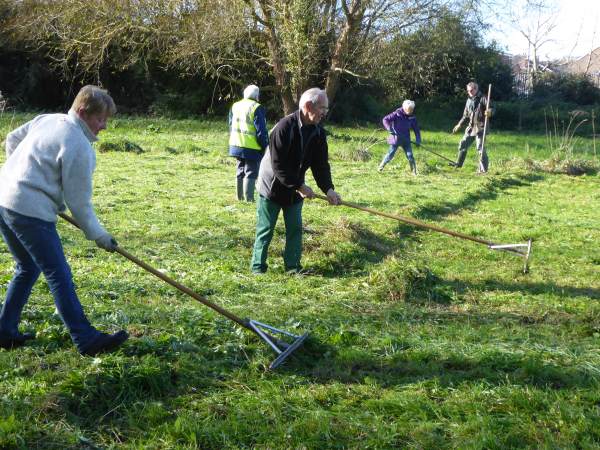
After coffee break
they moved down to the south meadow where they also
cleared the cutting from the south east corner. The
cuttings were used to create a new hibernaculum near
the start of the south path.

No special wildlife
observations apart from the continuing presence of Red
Admirals - somewhat dozy in the chilly weather.
A full report along
with more photos is on the web site at . . .
https://www.brookmeadow.org.uk/conservation-news/
Warblington
shore
Peter
Milinets-Raby visited the Warblington shore this
morning (7:13am to 8:46am - tide coming in). He just
walked down through the cemetery and viewed the shore
off Pook Lane.
Loads of waders to watch - Really great! 132
Bar-tailed Godwit, 98 Black-tailed Godwit, 12 Grey
Plover, 251 Dunlin, 8 Knot, 1 Lapwing, 2 Greenshank,
146 Brent Geese, 31 Shelduck, 6 Wigeon, 6 Sandwich
Tern, 6 Teal, 2 Great Crested Grebe.
Then, Peter met up
with John Norton and they went and twitched the Sea
Storksbill plant at Blashford Lake (see photo -
leaves were less than one centimetre in size!!).

Otherwise, Peter says,
"it was a big dip, with the Lesser Scaup not showing.
We did see Ferruginous Duck, the juvenile Pink-footed
Goose, Goosander, Redpoll etc. etc. Now that has put
me off twitching for another ten years at least. I'll
stick to our local patch and see great birds, as
above". Good decision Peter. What more could you wish
for from birdwatching?
FRIDAY
NOVEMBER 3 - 2017
Autumn
patrol
I did a patrol
around my local patch on this lovely autumn morning
with the sun shining and bird song in the air (well,
Robin at least). I went through Brook Meadow, down to
Peter Pond and Slipper Millpond before coming back
through the meadow.
I was pleased to meet up with my old friend Barry
Collins who was cycling through Brook Meadow on his
way home from bird counting on Thorney Deeps. Barry
used to be the Conservation Warden of Thorney Island
and certainly knows more about the island and its
wildlife than anyone else. He informed me that four
pairs of Little Egrets nested at the Deeps this
summer, producing 11 youngsters.
Barry commented on the number of Red Admiral
butterflies he had seen. I would echo this
observation, as they seemed to be everywhere on my
walk too - I must have seen at least 10 in total. Here
is one that perched for me on some Nettle leaves.
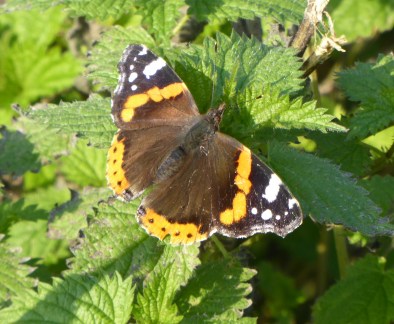
Red Admirals migrate
to Britain from the Continent. As the nights get
colder, there is some evidence of a return migration,
but many (probably most) will hang around, trying
(usually unsuccessfully) to find somewhere to
hibernate. It is certainly not unusual in our parts to
see a Red Admiral flying on a warm day in mid-winter
and they are now becoming known as an
all-the-year-round butterfly. Maybe, as the climate
warms up, they will join Comma, Peacock, Small
Tortoiseshell and Brimstone as over wintering
butterflies.
Walking down Lumley
Road past Peter Pond two unusual flowers caught my
attention: a plant of Red Clover with
exceptionally large flower heads and what is almost
certainly an escaped cultivated Flax.
Three of the swan
cygnets were on Peter Pond,
all now well-grown and healthy. No sign of the
parents.
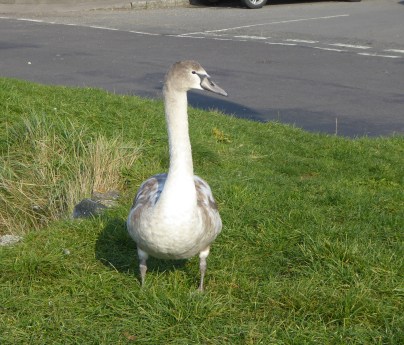
It was good to see
members of the Slipper Millpond Preservation
Association hard at work on the east side of the
millpond, cutting and clearing a section of the bank
to encourage new growth in the spring. This was an
impromptu work session brought forward due to forecast
rain tomorrow.


Langstone
Mill Pond
Yesterday
Peter Milinets-Raby had a quick visit to Langstone
Mill Pond from 9am to 10:03am - high tide - Not much
seen, with no waders around! However, a bright sunny
day with some super reflections. Here is a male Teal.

On the pond were 27
Teal, 4 pairs of Shoveler, 5 Grey Herons, 3 Little
Egrets, a Kingfisher dashed across the pond and a
Cetti's Warbler was heard singing and a Water Rail was
also heard squealing.
On the high tide waters were an impressive flock of 18
Red Breasted Merganser (mostly eclipse plumaged
females - a couple of clear eclipse plumaged males)
and 9 Wigeon.
Flying over still on migration were 5
Skylarks.
WEDNESDAY
NOVEMBER 1 - 2017
Nore
Barn
It was a
glorious autumn morning - ideal for a bit of
birdwatching at my favourite site to the west of
Emsworth. I got to Nore Barn at about 11.30 where the
tide was falling and the mudflats slowly emerging. The
regular Spotted Redshank was already feeding in
the stream with a Common Redshank and a couple of
Black-tailed Godwits, but there was no sign of its
regular feeding companion, the colour-ringed
Greenshank.
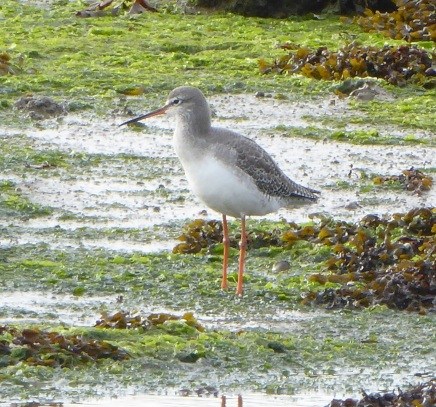
I walked along the
path south of the woods from where I had a cracking
view of a flock of 78 Black-tailed Godwits in
the creek. I spoke to several passers by who were
interested to learn about these interesting birds and
where they had come from.

I found three
colour-ringed Godwits in the flock:
G+GY - Ringed Farlington 14-Sep-05. Last seen
on Oct 29. My 16th sighting.
R+LG - This was my first sighting this winter
and my 12th overall. First seen in Emsworth on
23-Oct-13. Seen each winter since then but only in
Oct-Nov.
W+WN - This is a welcome return of an old
friend. It was ringed on 05-Sep-10 at Farlington
Marshes and has been a regular winter visitor to
Emsworth Harbour since then. This was my first
sighting this winter and my 68th overall.
It was good to meet up
with Peter Milinets-Raby whose report follows.
Langstone
to Emsworth
Langstone Mill
Pond (11:01am to 11:40am - tide starting to drop). On
the pond were 2 pairs of Shoveler and 51 Teal.
As the tide dropped in flew 3 Greenshank (G//R
+BR//-), 26 Black-tailed Godwit (R//R +GR//- &
B//R + WR//- & B//R + LN//- & G//R + BG//-), a
single Dunlin, 43 Brent Geese and 19 Wigeon.
Off Conigar Point in the distance were 7 Red Breasted
Mergansers, 38 Brent Geese, a female Pintail (Perhaps
the pond one??), 18 Wigeon and a single Sandwich Tern
flying around feeding.
Nore Barn: Whilst the tide was still falling I quickly
popped around to Nore Barn (11:50am to 12:31pm). I
counted 7 Grey Plover, 9 Shelduck, 68 Dunlin, 53
Wigeon, a single Bar-tailed Godwit, 112 Black-tailed
Godwits, 2 Greenshank (RO rings, other leg tucked
away), 1 Turnstone, 138 Brent Geese, 9 Teal and the
regular Spotted Redshank in the stream being
photographed.

Beacon Square had a
further 29 Brent Geese and 4 Wigeon. No obvious
juvenile Brent seen amongst all that was
counted!
As an extra treat
Peter sent a Greater Flamingo from Axios Marsh
in Greece where he spent a family holiday. Other birds
were Dalmatian Pelican and Pygmy
Cormorant.
For
the previous month go to . . October
1-30